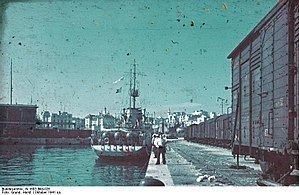Name Amiral Murgescu Name Don Launched 14 June 1939 Draft 2.5 m | Laid down August 1938 Namesake River Don Length 77 m | |
 | ||
Namesake Admiral Ioan Murgescu (ro) Captured By the Soviet Union, 1944 | ||
NMS Amiral Murgescu was a minelayer of the Romanian Navy, the first sea-going warship built in Romania. She was laid down at the Galați shipyard in August 1938 and launched on 14 June 1939.
Contents
Description
She had a crew of up to 135, a standard displacement of 812 tons and a maximum displacement of 1,068 tons, a length of 77 meters, a beam of 9.1 meters and a draught of 2.5 meters. She was powered by two Krupp diesel engines generating 1,100 horse power each, had a top speed of 16 knots and a range of 3,400 nautical miles. Her armament consisted of two 102 mm Bofors dual purpose naval/anti-aircraft guns, two 37 mm Rheinmetall anti-aircraft guns, four 20 mm Oerlikon anti-aircraft guns and two 13.2 mm machine guns. She was able to carry up to 135 mines.
Service
Her first mission was between 16 and 19 June 1941, when she and two other Romanian minelayers, Regele Carol I and Aurora, laid a barrage of 1,000 mines between Cape Midia and Tuzla, to protect the main Romanian port of Constanța. When the Soviet Black Sea Fleet attacked the port on 26 June, she helped repel the attack, together with the destroyers Mărăști and Regina Maria and the German coastal battery Tirpitz. The Soviet destroyer leader Moskva was sunk by Romanian mines and Amiral Murgescu also shot down two Soviet aircraft on that same day. Later, the Soviet submarine Shch-213 and 3 more Soviet submarines (M-58, M-34 and Shch-208) were sunk by Romanian mines near Constanța. The German minesweeper R-36 was also sunk by Romanian mines near Constanța in 1942.
In July, the gun shields protecting her two 102 mm guns were removed in order to facilitate anti-aircraft fire. During a Soviet air attack on Constanța on 5 August, she shot down three more aircraft. In total, she shot down 12 Soviet aircraft.
Her next mission was between 7 and 16 October 1941. Together with the Romanian minelayers Regele Carol I and Dacia and escorted by the Romanian 250t-class torpedo boats Năluca, Sborul and Smeul, Romanian gunboats Sublocotenent Ghiculescu and Căpitan Dumitrescu and Bulgarian torpedo boats Drazki, Smeli and Hrabri, she laid four full minefields and one partial minefield along the Bulgarian coast. These mines later sank 4 Soviet submarines (S-34, L-24, Shch-210 and Shch-211).
In February 1942, she participated in a minelaying operation near Sulina, at the mouth of the Danube. When she was not used as a minelayer, she was employed as a convoy escort.
On 24 June 1942, she laid mines near Odessa along with Dacia, while being escorted by the Romanian destroyers Regele Ferdinand, Regina Maria and Mărășești, Romanian gunboats Ghiculescu, Stihi and Dumitrescu and Romanian torpedo boat Smeul as well as motor minesweepers of the Donau Flotilla. The mines laid near Odessa later sank the Soviet submarines M-33 and M-60.
In May 1944, she was the last Romanian warship to leave Crimea during the evacuation of the peninsula by the Axis. Commanded by Lieutenant Commander Anton Foca, she evacuated about 1,000 troops, including the highly-decorated German General Walter Hartmann. On 29 May 1944, she was decorated with the Order of the Star of Romania.
After the 23 August 1944 coup, she was captured by Soviet forces and commissioned as Don. She was decommissioned in 1967, as she was considered worn out and not worth refitting. She was then used as a repair and depot ship for two more decades before being sold for scrap in 1988.
